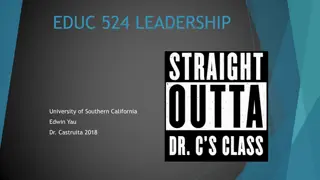
Understanding South Carolina Politics Through History and Government Structure
Delve into the rich history and government structure of South Carolina, from its colonial roots to the present-day political landscape. Explore key events, the role of the General Assembly, and the executive branch's functions in shaping the state's governance.
Download Presentation

Please find below an Image/Link to download the presentation.
The content on the website is provided AS IS for your information and personal use only. It may not be sold, licensed, or shared on other websites without obtaining consent from the author. If you encounter any issues during the download, it is possible that the publisher has removed the file from their server.
You are allowed to download the files provided on this website for personal or commercial use, subject to the condition that they are used lawfully. All files are the property of their respective owners.
The content on the website is provided AS IS for your information and personal use only. It may not be sold, licensed, or shared on other websites without obtaining consent from the author.
E N D
Presentation Transcript
South Carolina Politics 101 John T.R. Holder, Ph.D. Department of Political Science John C. West Forum on Politics and Policy Winthrop University NEW Leadership South Carolina Forum May 15, 2017
Province of Carolina Province of Carolina Royal Charter granted by King Charles II, 1663, revised 1665 Northern boundary: present Va.-NC state line Southern boundary: northern edge of Spanish territory in Florida (south of present-day Jacksonville) Western boundary: South Seas (Pacific Ocean) Charles Town (Charleston) established 1670 North Carolina and South Carolina were separated for administrative convenience in 1710 or 1712 Georgia was split off from SC in 1732 Tennessee was split off from NC in 1790 s
Constitutions Constitutions John Locke wrote the Fundamental Constitutions of Carolina in 1669, even before the province was settled by Europeans. The current state Constitution was drafted in 1895 and ratified in 1896, after former Confederates had regained political power. It is the eighth Constitution in state history. Designed to preserve white supremacy and disenfranchise most blacks and poor whites.
SOUTH CAROLINA GENERAL ASSEMBLY SOUTH CAROLINA GENERAL ASSEMBLY Constitutionally strongest branch of state government Senate and House of Representatives Each elected from individual districts 46 Senators serve 4-yr. terms elected in Presidential election years Currently 27 R, 18 D, one vacancy (special election on May 30, 2017) 124 Representatives serve 2-yr. terms Currently 78 R, 43 D, three vacancies One special election on May 30 and two on June 20 Lieutenant Gov. is President of the Senate This will change in 2018; the Lt. Gov. will become entirely a member of the executive branch, and the Senate will elect its President from the membership Speaker of the House is elected from the membership Senate is structured on seniority and has the filibuster House is more of a democracy and has no filibuster
SOUTH CAROLINA EXECUTIVE BRANCH SOUTH CAROLINA EXECUTIVE BRANCH Governor Lieutenant Governor Secretary of State Attorney General State Treasurer Comptroller General Superintendent of Education Adjutant General (commander of Nat l. Guard) Commissioner of Agriculture All individually elected in off-years (2010, 2014, etc.) In 2010, for the first time in history, Republicans won all nine statewide offices; this was repeated in 2014 Beginning in 2018, the Governor and Lieutenant Governor will run as a ticket, and the Governor will appoint the Adjutant General
SOUTH CAROLINA JUDICIARY SOUTH CAROLINA JUDICIARY Almost all judges in SC are elected by the General Assembly Most judges are former legislators Supreme Court: 5 Justices, 10-year terms (but mandatory retirement at 72), elected at two-year intervals Longest-serving traditionally serves as Chief Justice The current Chief Justice is Donald W. Beatty The first woman to serve on the SC Supreme Court, Jean Hoefer Toal, retired in 2015 The second woman, Justice Kaye Hearn, is on the court now Court of Appeals: 9 judges, six-year terms 46 Circuit Court judges, six-year terms Family Court, Probate Court Local courts, magistrates
State Legislatures 2017 #Women #Seats 1830 25 71 39 61 41 23 18 19 10 %Women NATIONAL 1. Nevada 2. Vermont 3. Colorado 25. Georgia 30. North Carolina 47. South Carolina 48. West Virginia 49. Oklahoma 50. Wyoming 7383 63 180 100 236 170 170 134 149 90 24.8 39.7 39.4 39 25.8 24.1 13.5 13.4 12.8 11.1
DIVERSITY? DIVERSITY? Nikki Haley was the first Governor of South Carolina who was not a white male. She appointed Tim Scott as the first black U.S. Senator from SC in 2013. Nancy Stevenson (served 1979-1983) was the only woman to be Lieutenant Governor. Chief Justice Jean Toal (Associate Justice, 1988-1999; Chief Justice, 1999-2015) and Justice Kaye Hearn (2009-present) are the only women ever to have served on the SC Supreme Court. Toal was previously the first woman committee chair in the General Assembly. Elizabeth Patterson of Spartanburg (served 1987-1993) is the only woman ever elected to Congress from South Carolina who did not succeed her deceased husband. James Clyburn and Tim Scott are the only black members of Congress from South Carolina since Reconstruction. South Carolina has never had a woman U.S. Senator. From 2008 to 2012, the SC Senate was the only state legislative body in the country without a woman member. One woman was elected in 2012, a second in 2015, and two more in 2016. There are now four.
Traditionalistic Political Culture Traditionalistic Political Culture Defined by Daniel J. Elazar, 1984 Belief that the role of government is to preserve order (as opposed to making a better society through things like social welfare programs) Preservation of order = resistance to change (men have run things for thousands of years, why stop now?) Preservation of order = military defense and law enforcement, which require physical strength, so women traditionally have not been entrusted with these responsibilities Result: Very few women in positions of political authority
A Tale of Two States Kansas S.C. Trump % 2016 Clinton % 2016 Women on state Supreme Court First woman Governor Second woman Governor First Congresswoman who didn't succeed her husband First woman U.S. Senator Second woman U.S. Senator 57 36 55 41 2 of 7 1990 2002 1932 1 of 5 2010 Not yet 1986 1978 1996 Not yet Not yet
KANSAS SENATE 2017 KANSAS SENATE 2017 40 members 31 Republicans, 9 Democrats 25 men, 15 women 20 Republican men 11 Republican women 5 Democratic men 4 Democratic women Leadership positions held by women: President of the Senate (R) Assistant Majority Leader (R) Majority Whip (R) Minority Whip (D) Assistant Minority Leader (D) There are more Republican women Senators (11) than there are total Democrats (9).
South Carolina Senate Districts
LACK OF COMPETITION: LACK OF COMPETITION: 2016 SC SENATE (46 Seats) 2016 SC SENATE (46 Seats) 25 Republican incumbents sought re-election 12 were unopposed 11 had opponents in the Republican primary but not the general election 1 had a Democratic opponent in the general election 1 had a third-party opponent in the general election, but no Democrat 17 Democratic incumbents sought re-election 7 were unopposed 4 had opponents in the Democratic primary but not the general election 6 had Republican opponents in the general election 3 open seats had Republican primaries but no Democratic candidate 1 open seat had both Democratic and Republican candidates *Only 8 of 46 seats had both Democrats and Republicans running in the general* 37 of 46 members were re-elected
LACK OF COMPETITION: LACK OF COMPETITION: 2016 SC HOUSE (124 Seats) 2016 SC HOUSE (124 Seats) 70 Republican incumbents sought re-election 42 were unopposed 8 had opponents in the Republican primary but not the general election 10 had Democratic opponents in the general election but no Republican primary opponent 4 had third-party opponents in the general election, but no Democratic opponent 6 had both a Republican primary opponent and a Democratic general election opponent 40 Democratic incumbents sought re-election 26 were unopposed 6 had opponents in the Democratic primary but not the general election 5 had Republican opponents in the general election, but no Democratic primary opponent 1 had a third-party opponent in the general election, but no Republican opponent 2 had both a Democratic primary opponent and a Republican general election opponent 14 open seats 4 had only Republican candidates 1 had only Democratic candidates 9 had both Democratic and Republican candidates *Only 32 of 124 seats had both Democrats and Republicans running in the general* 103 of 124 members were re-elected
Lack of Competition Lack of Competition It was mathematically impossible for the Democratic Party to gain control of the Senate because there aren t enough Democrats running, even though every seat was up for election. Of the 124 House seats, 58 had no Democratic candidate. Most turnover in legislatures occurs through open seats (retirements, deaths, resignations) rather than incumbents being defeated when they run for re- election. But when there s no competition, there s no possibility of turnover. When there s no turnover, there s no opportunity for new people to serve. If new people don t have the opportunity to serve, there s no way to increase the number of members from underrepresented groups. Why no competition? Partisan gerrymandering If an incumbent is defeated, it s more likely to be in the primary than in the general election Incumbency advantage fundraising, networking, etc. Term limits exist for state legislatures in 15 states, but not in SC.
History of the State House History of the State House Political disputes between the Charleston aristocracy and the rest of the state led to an agreement to move the state capital inland. Columbia was established in 1786 as the first city in the US specifically founded as a state capital. The first State House in Columbia burned down while under construction in 1788.
History of the State House History of the State House The second State House in Columbia was built in 1790, next to the current one. Hoban also did the White House.
History of the State House History of the State House Construction on the current State House began in 1851 and was interrupted by the Civil War. The building was damaged by Union troops, Feb. 1865. Construction was completed in 1903. The building was extensively renovated between 1995 and 1998. It is now earthquake-proof.
Interesting Things to See Interesting Things to See at the State House at the State House The Ordinance of Secession is engraved in marble in the entryway of the main lobby, while the U.S. Constitution is on a plaque in a corner of the basement. (Priorities?) The John C. Calhoun statue in the lobby has a chunk broken off from its base. When it was being moved back into the building after the 1990 s renovation, the crane dropped it.
Interesting Things to See Interesting Things to See at the State House at the State House The House office building is named for Solomon Blatt. Blatt was a state representative from Barnwell County from 1929 until his death in 1986 at age 90 (over 57 years). By comparison, Strom Thurmond was in the US Senate for less than 48 years. Blatt was Speaker of the House for all but four years from 1937 to 1973. At the time of his death, Blatt was described as the longest- serving member of an elected legislative body in the non- Communist world.
Interesting Things to See Interesting Things to See at the State House at the State House In the lobby, if you look up to the rotunda, you are not seeing the inside of the dome which is visible outside. There are actually two domes, one inside the other.
George Washington Statue George Washington Statue Sherman s troops broke off the cane in Washington s hand. It has deliberately never been repaired.
Brass stars where Shermans artillery hit the building, Brass stars where Sherman s artillery hit the building, deliberately never repaired. deliberately never repaired.
Strom Thurmond Statue Strom Thurmond Statue Thurmond s children s names are engraved on it. After his death, when Essie Mae Washington-Williams was acknowledged to be his daughter, her name was added to the statue. Father of Four Children had to be altered to Father of Five Children. The re-engraving is not perfect and you can see where it was changed. A recently published biography of Sen. Thurmond has as its epilogue a chapter called The Scarred Stone, referring to this.






















